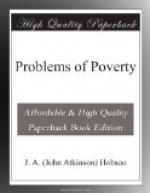Now what does London do with this increase? Is it spread evenly over the surface of the great city?
Certainly not. And here we reach a point which has a great significance for those interested in East London. It is clearly shown that none of this gain goes to swell the numbers of East London. Many individual strangers of course go there, but the outflow from East London towards the suburban parts more than compensates the inflow. By comparing the population of East London in 1901 with that in 1881, it is found that the increase is far less than it ought to be, if we add the excess of births over deaths. How is this? The answer is not far to seek, and stamps with fatal significance one aspect of Poverty, namely, overcrowding. East London does not gain so fast as other parts, because it will not hold any more people. It has reached what is termed “saturation point.” Introduce strangers, and they can only stay on condition that they push out, and take the place of, earlier residents.
So we find in all districts of large towns, where poverty lies thickest, the inflow is less than the outflow. The great stream of incomers goes to swell the population of parts not hitherto overcrowded, thus ever increasing the area of dense city population. Districts like Bethnal Green and Mile End are found to show the smallest increase, while outlying districts like West Ham grow at a prodigious pace.
Sec. 2. Rate of Migration from Rural Districts.—But perhaps the most instructive point of view from which to regard the absorption of country population by the towns is not from inside but from outside.
Confining our attention for the present to migration from the country to the town, and leaving the foreign immigration for separate treatment, we find that the large majority of incomers to London are from agricultural counties, such as Kent, Bucks, Herts, Devon, Lincoln, and not from counties with large manufacturing centres of their own, like Yorkshire, Lancashire, and Cheshire. The great manufacturing counties contribute very slightly to the growth of London. While twelve representative agricultural counties furnished sixteen per 1000 of the population of London in 1881, twelve representative manufacturing counties supplied no more than two-and-a-half per 1000.
Respecting the rate of the decline of agricultural population exaggerated statements are often made. If we take the inhabitants of rural sanitary districts, and of urban districts below 10,000 as the rural population, we shall find that between 1891 and 1901 the growth in the rural districts is 5.3 per cent. as compared with 15.8 per cent. for the centres of population. Even if the urban standard be placed at a lower point, 5000, there is still an increase of 3.5 per cent. in the rural population. If, however, we eliminate the “home” counties and other rural districts round the large centres of population, largely used for residential purposes, and turn to agricultural




